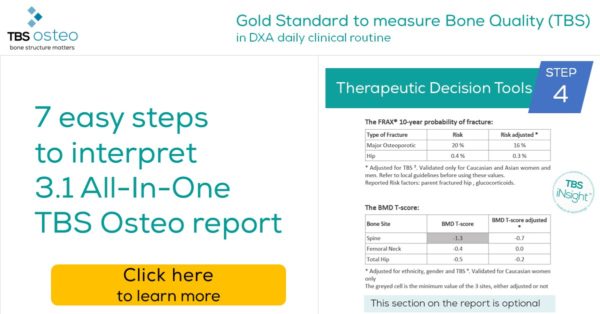Download the 7-step guide:
The new 3.1 All-in-One TBS Report is divided into 7 steps. In the next few days, we will show you how easy it is to use the new report in daily clinical routine.
Today – STEP 4 of 7 – Therapeutic Decision Tools
- Individualize treatments decisions:
This section provides information tools that can be used to help you make the most appropriate therapeutic decisions.
- Using FRAX when appropriate:
- Risk category: displays FRAX probabilities provided by the DXA software
- Risk adjusted category: displays FRAX probabilities adjusted for TBS, taking into account the status of the trabecular bone microarchitecture in the fracture risk assessment (1)
- Using BMD T-score when appropriate.
- BMD T-score: displays T-scores computed by the DXA software
- BMD T-score adjusted: displays T-scores adjusted for TBS for women only.(2)
The adjustment of the T-score is the application of the equation that is available in the scientific literature(2). No indication is provided on how to use this adjusted value versus the regular BMD T-score. The formulas to adjust the BMD T-score are explained in the TBS iNsight – Technical Guide. In the BMD T-score column are the BMD T-scores provided by DXA software while BMD T-scores adjusted are BMD T-score adjusted for ethnicity, gender and TBS. The greyed cell is the minimum value of the 3 sites, either adjusted or not.
Different drugs (anabolic or anti-resorptive) impact the bone density and the microarchitecture differently. Knowing both the BMD and TBS of your patient, as well as his/her clinical context, is crucial to better understand your patient’s bone health and to choose the best beneficial approach.
What to do?
Based on the local guidelines in your country, these new decision tools (based on the FRAX Risk adjusted or the BMD T-score adjusted) may help you estimate the actual risk of fracture of the patient and take the most appropriate decisions regarding therapy.
Download the 7-step guide:
References:
(1) McCloskey, E.V., Oden, A., Harvey, N.C., Leslie, W.D., Hans, D., Johansson, H., Kanis, J.A., 2015. Adjusting fracture probability by trabecular bone score. Calcif Tissue Int 96,
500–509. https://doi.org/10.1007/s00223-015-9980-x
(2) Leslie, W.D., Shevroja, E., Johansson, H., McCloskey, E.V., Harvey, N.C., Kanis, J.A., Hans, D., 2018. Risk-equivalent T-score adjustment for using lumbar spine trabecular
bone score (TBS): the Manitoba BMD registry. Osteoporos Int 29, 751–758. https://doi.org/10.1007/s00198-018-4405-0
As a reminder the main features of the 3.1 All-In-One TBS Osteo report are:
- Completely new and intuitive design to simplify the interpretation of the BMD and TBS exam.
- Bone health report – All-In-One: TBS and BMD results in one report
- New BMD T-score adjusted for TBS
- Fracture risk grid – A visualization of BMD and TBS combined assessment
- Automatic and editable conclusion developed by international experts to communicate easily with referring doctors
Feel free to share with your colleagues, as it helps identify more patients at risk for fracture. If you have questions, contact us at support@medimapsgroup.com – we will gladly help you.
Click here to follow us on LinkedIn.
You can find more information on all 7 steps below:

